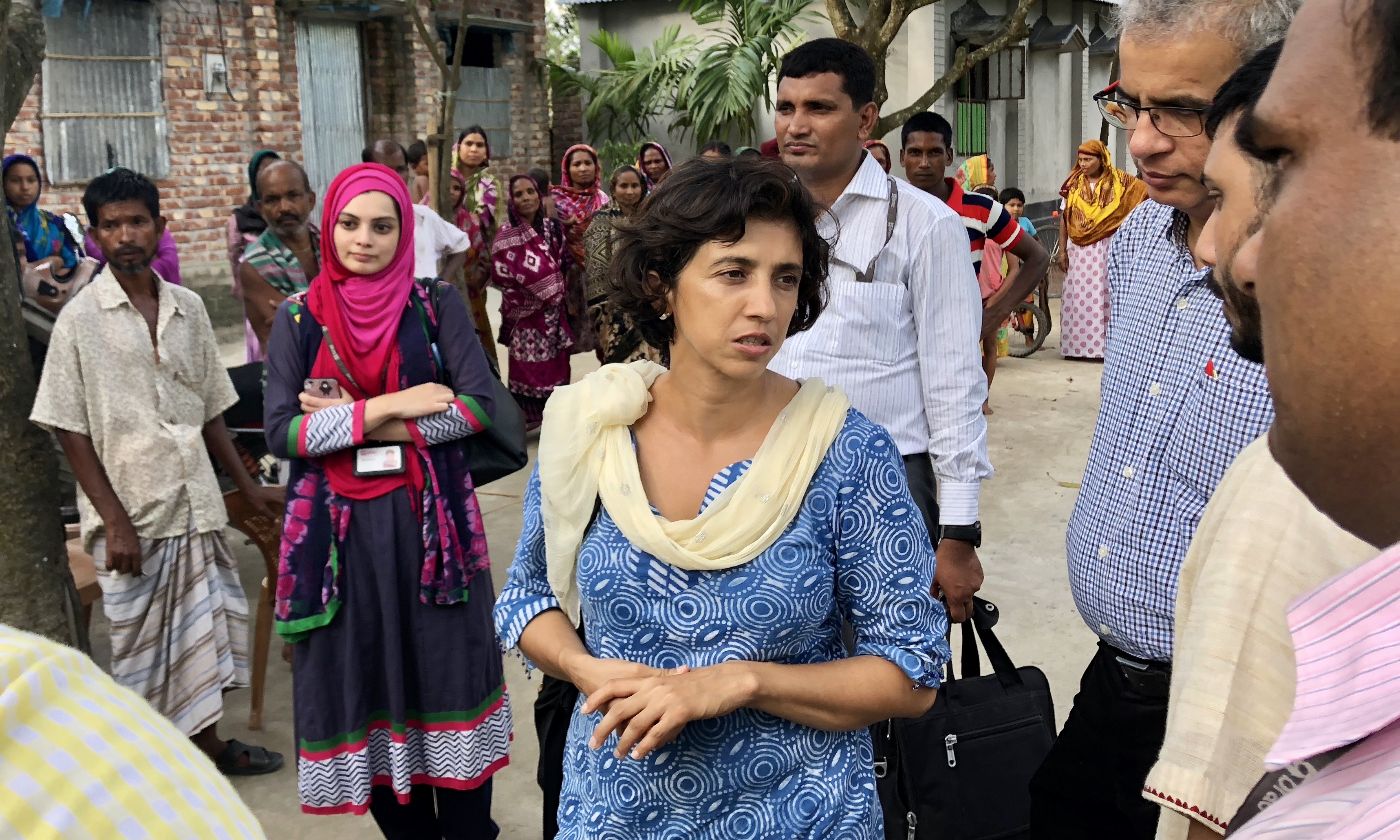In Conversation: Penny Goldberg & Rohini Pande on gender & economic growth
In the first installment of EGC’s “In Conversation” series – pairing Yale economics faculty with different perspectives on international development – faculty leaders for EGC’s Gender & Growth Gaps project discuss the complex relationship between gender inequality, labor markets, and economic growth.

Gender has long interested many economists, but it has only recently garnered substantial momentum and prominence in the field. For many years, research on gender issues was limited by inadequate data and metrics – and the field’s legacy of gender imbalances, and a tendency to overlook gender in favor of other economic topics also played a role.
To help accelerate this momentum, Yale’s Economic Growth Center (EGC) launched the Gender and Growth Gaps project. As highlighted by its inaugural white paper, the project integrates macroeconomic and microeconomic perspectives to explore how gender inequality affects economic outcomes in low- and middle-income countries (LMICs).
In the first of a new series called “In Conversation,” EGC discussed the initiative with two of its Yale faculty leaders: Pinelopi (Penny) Koujianou Goldberg, the Elihu Professor of Economics and Global Affairs and an EGC affiliate, and Rohini Pande, the Henry J. Heinz II Professor of Economics, Director of EGC. The content has been edited for length and clarity.
In the Gender and Growth Gaps project’s white paper, you try to answer a big question: does growth reduce gender gaps? Why is that question important, and what were your findings?
Pande: On average, richer countries have smaller gender gaps – but as empirical economists, we always ask: is that a causal relationship?
Goldberg: From a policy perspective one relevant question is, can we trust growth to close gender gaps? If so, perhaps we shouldn't worry – from a purely economic standpoint – about gender discrimination and other gender distortions, because growth is going to take care of them. But looking at recent trends with better data – the World Bank’s Global Jobs Indicator (JOIN) database – and using many different metrics of women’s economic standing, we get a nuanced answer to the above question. What emerged from our analysis was, essentially, that there is no clear takeaway. If you look over time across countries, there's no clear relationship between growth and gender gaps.
Pande: We found that these relationships vary a lot by region. In Latin America, for instance, it seems like growth reduced gender gaps, but not in South Asia. Certainly, as countries get richer, the market economy becomes more important – so both genders are more likely to work for a wage as economies grow. Unfortunately, it also happens to be the case that women are also just less likely to work. This echoes work by Claudia Goldin – who won the Nobel Prize last year – on the U-shape relationship between GDP and women's work. When you're a very poor country, everyone works in subsistence agriculture, including many women. But as you get richer, men start moving to better opportunities in manufacturing and services, while many women stay at home.
Goldberg: There’s a lot of interesting work going on right now to explore the question of why structural transformation looks so different for men and women. For instance, in a new paper Gaurav Chiplunkar and Tatjana Kleineberg, both former Yale students, find that the pattern varies quite substantially between countries. As economies transition from agriculture to services, women often drop out of the labor force completely – which may explain, for instance, what has happened in countries like India. Even though India has been growing so fast in recent decades, women’s labor force participation has declined.
Pande: Social norms matter, too. When economies transition, gender norms may cause women to get left behind: if men are seen as the breadwinners, they will get those jobs first. But norms or beliefs play out quite differently across countries. Globally, there is a lot of concern that we’re just not creating enough jobs – and combined with norms, that may be particularly deadly when it comes to women getting jobs. With technologies like AI, and what they may do to jobs in the future, we may want to also think about how these shifts will interact with beliefs about who deserves a job.
Your white paper also discusses some work on the reverse question: does reducing gender gaps drive economic growth?
Goldberg: Around the world, there are many settings where women are excluded from economic life. Would those economies do better if women were integrated into labor markets? The very few rigorous studies that have been conducted so far find a very large, a very strong effect: they show that reducing gender gaps is good for economic growth.
We also asked: If incorporating women into the labor force is associated with such positive gains, why hasn't it already happened? For a long time, women had to stay home to raise the children and were seen as not physically fit enough to do heavy labor. But while “brawn” might partially explain the gender gaps of previous centuries, it cannot explain them now. There is something else going on – and in the white paper, we explore several different hypotheses.

Penny Goldberg at the Firms Trade and Development conference, October 2024.
What are some of the most compelling findings about factors that can help reduce gender gaps?
Pande: There is quite a bit of evidence that laws matter. Some Indian states, for instance, have laws that mandate women can't work at night. Informal laws, or norms or community beliefs, also seem to be strong constraints. One way of effecting change is to identify ways to increase women’s presence in politics and, more broadly, management and leadership positions. We have significant evidence that female leaders help other women get a foothold in the labor market.
Goldberg: One of my papers with Gaurav Chiplunkar documents that women entrepreneurs in India tend to employ more women. It turns out that this has important implications – if you promote female entrepreneurship, it means you get more female entrepreneurs but also more women workers, which increases labor demand and tends to raise their wages.
In the broader agenda, how can you accelerate more research and evidence on gender issues?
Pande: A side-effect of doing this literature review was that we pulled together all the papers published in the top journals since roughly 2000 that mention gender in their abstract – and it was striking to see a very significant increase. Since we had the data, we looked for any correlations between women researchers, journals with women in editorial positions, and publications mentioning gender. And we found that, indeed, women are more likely to be co-authors on papers that relate to gender, and such publications are more likely to occur in publications where women are in senior editorial positions.
Goldberg: In the past, the prevalent view in the profession, sometimes expressed explicitly, was that you shouldn’t work on gender because you'll never get a job. So, people just didn’t write papers on gender. When they did, many wouldn’t make it past the first cut – they would get desk-rejected. So having a woman in the editor position, or as referees, can be quite important.
What were the main motivations for establishing EGC’s Gender and Growth Gaps project, and how has the project evolved?
Pande: These issues, which have at the heart of it the links between households and labor markets, have been of longstanding interest to economists at EGC – particularly our colleagues Paul Schultz and Mark Rosenzweig’s work going back to the 1980s. Nancy Folbre – one of the leading researchers on the care economy – was an EGC postdoctoral fellow in the 1970s, when she started working on the links between intra-household issues in the labor market and what that means for women.
More recently, with more data available, there’s been a renewed interest. The broad question is, what happens to male and female labor force participation during the process of structural transformation – as countries develop out of agriculture-based economies, usually into manufacturing and services?
Goldberg: A number of our colleagues have looked at this in different ways. Fabrizio Zilibotti and Michael Peters, for instance, have explored the dynamics of structural transformation in India and what that meant for urban-rural inequality – but also, are men and women reacting differently to this process? On the micro side, for a long time our colleague Orazio Attanasio has been thinking about how to measure subjective beliefs: how do people decide what is right or appropriate to do, including men and women’s labor market choices?
Pande: The aim of this project was to start a broad conversation by bringing together people with different perspectives who are working on very similar questions – and engage a lot more with policy counterparts on these topics.
 Vestal McIntyre
Vestal McIntyre
Rohini Pande at a study site in rural Bangladesh, August 2018.
What do you see as the top policy priority for reducing gender gaps to spur growth?
Pande: The most important thing is to recognize that women are not a problem to be solved – they are part of the solution. I can understand why many people don’t see it this way yet; you want to be gender-blind and believe you're in a world where you're fighting for equal opportunity. But that leads us to a very abstract notion of development, rather than actually thinking about the people who are being affected. The bottom line is clear: if you care about productivity, if you care about growth, you can't have a strategy that doesn’t include a focus on women.